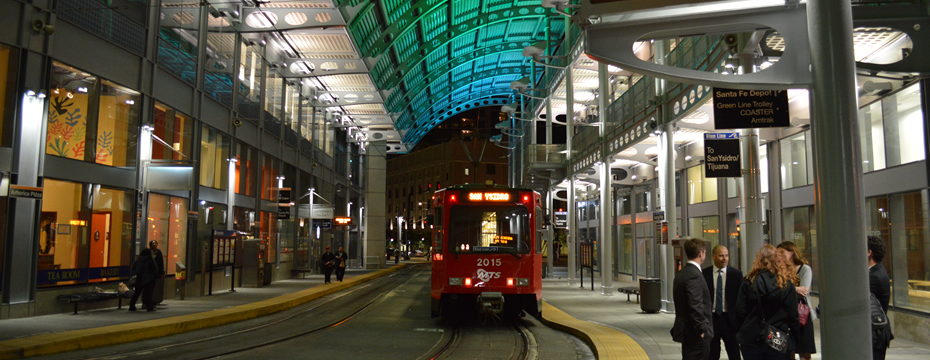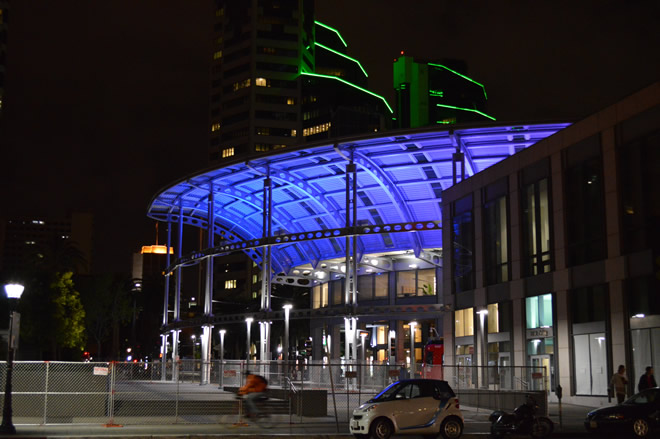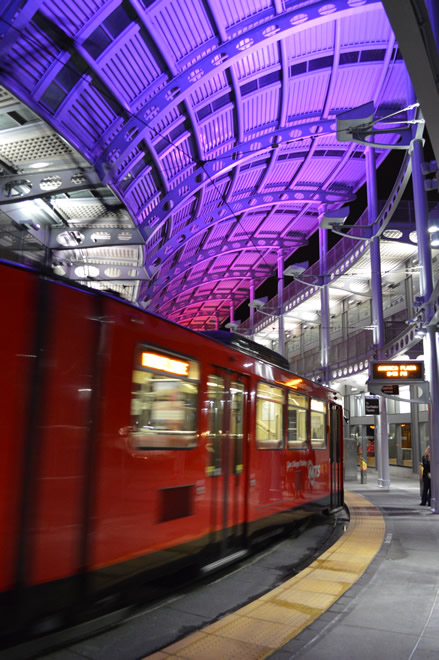Source: Philips Lumec Blog
The San Diego Trolley Station at One America Plaza bustles each day with commuters traveling to and from work and tourists out and about seeing the historical sites of the city. Unlike typical dim and dismal public transportation stops, this station is adorned with a distinguishing feature—a stunning canopy of steel girders and opaque glass designed by acclaimed architect, Helmut Jahn. The canopy covers the waiting area and creates an overpass for the trolley as it enters and exits the station.
 |
|
All San Diego Trolley Station photos courtesy of Juan Ceballos and Debra Fox. |
Jahn designed the curving 50 ft (15.2 m) wide, 50 ft (15.2 m) tall canopy more than 25 years ago in conjunction with his obelisk-shaped One America Plaza Tower, the tallest building in San Diego. Jahn’s intention was to blend the feel of a cosmopolitan, European train station with the “surf city” climate of San Diego. On one side, the structure is attached to San Diego’s Museum of Contemporary Art. On the other, it is adjacent to an outdoor plaza that serves as a walkway to and from the Santa Fe Depot Station, the commercial train hub for the city.
The canopy was originally lit with metal halide fixtures that did not provide adequate light for the space below, resulting in safety and security concerns. The maintenance of the fixtures was both labor and cost intensive—often requiring a scissor lift to reach fixtures up to 35 ft (10.7 m) in the air—and disruptive to the trolley service. The lights could sometimes run for up 15 hours resulting in expensive electric bills. Given the safety concerns and costs, it was time to seek an alternative lighting solution.
Lighting designers, Rebecca Ceballos and Debra Fox of LPA, Inc., were commissioned with the task. The design objective for the project was two-fold—to improve the light levels and light uniformity, to increase safety, and to reduce the maintenance and energy costs. Ceballos and Fox knew that an LED lighting system would achieve both goals. It would also be a way to introduce color-changing light to highlight Jahn’s design and provide a unique experience for people traveling through the station. As the project progressed, it became clear that the color-changing lighting would also provide another opportunity—to revitalize the city and the whole downtown experience.
 |
 |
“As we worked on the project we realized that through the use of color-changing lighting, we had the chance to essentially brand the city,” said Fox. “The new lighting could extend beyond the station and tie back to city events and happenings, and with the nearby commercial railroad station, we could create a ‘gateway’ to San Diego.”
To uplight the canopy, Ceballos and Fox used a combination of four Philips Color Kinetics ColorBlast Powercore and two iW Blast Powercore fixtures mounted within each of the 12 existing metal shrouds located 35 ft (10.7 ft) above the station which replaced high wattage metal halide uplights. More than 30 different themed lighting shows were programmed—both static and dynamic—and run during trolley operating hours treating travelers and passersby to a lighting experience. After hours, the uplights switch to white light in order to increase safety and security in the area. The new lighting system has reduced the overall energy consumption by 80%.
“It was exciting to take the objectives of the project one step further and have the chance to really make an impact on the city,” said Ceballos. “We hope the new lighting will instill pride in local citizens and create a welcoming and memorable entrance for visitors.”
Lighting Designers: Debra Fox & Rebecca Ceballos / LPA Inc.
Architect: Nick Arambarri / LPA Inc.
Owner: The Irvine Company
General Contractor: Suffolk Construction
Electrical Contractor: Dynalectric San Diego
Programmer: Scott Cain / Pharos Architectural Controls















